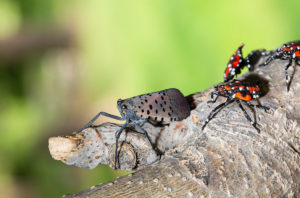After Covid-19, The Spotted Lanternfly Could Be Public Enemy No. 1
May 1, 2020There’s never been a better opportunity to play a huge role in supporting Pennsylvania’s farming community. How? Join us in the fight against the spotted lanternfly!
What is a spotted lanternfly?
The spotted lanternfly is a planthopper native to parts of China, India, Vietnam and eastern Asia. An adult lanternfly is about an inch long, with black-spotted gray forewings and hind wings with patches of red and black, and a white band. In the fall, they lay egg masses on their host trees.
It’s an invasive, destructive pest and an economic threat.
What do spotted lanternflies eat?

In May, the spotted lanternfly nymphs emerge. They molt through four stages, the earliest being the instar. These spotted lanternfly nymphs are wingless for the first part of their lives and they hop along trers or vines to feast upon the sap.
This insect also seems to prefer the Tree of Heaven (Ailanthus altissima), an invasive plant native to China. Unfortunately, the Tree of Heaven is so pervasive that it provides the spotted lanternfly with an abundant source of host plants.
Why are spotted lanternflies bad?
While the spotted lanternfly feeds off the sap from stone fruit trees, apple trees, hop vines, and the sap of some hardwood trees, they excrete a sticky honeydew that covers their host plant, promoting the growth of destructive mold and virtually blocking life-sustaining sunshine from reaching its host.
Applying insecticide while the spotted lanternfly is in the nymph stage ends its life cycle, playing a crucial role in its eradication. May-July is a critical time for stopping the destructive nymphs from reaching the adult egg-laying and egg-hatching stage.
No spotted lanternfly eggs, no future spotted lanternflies!
Dominion Pest Control is dedicated to the treatment and control of spotted lanternflies in the Lancaster County area. These insects are a major threat to Pennsylvania’s wine and beer industry, nurseries, forests, and other industries and assets because of their destructive nature. And although our winters are cold enough to kill the adult lanternfly, winter temperatures do not destroy the egg masses. Pest control measures are necessary.
According to the Center for Rural Pennsylvania, a legislative agency of the Pennsylvania General Assembly, the financial impact of the spotted lanternfly on Pennsylvania fruit growers, Christmas tree nurseries, and other industries statewide could amount to a loss of $554 million, with a loss of 4,987 jobs.
Already, this invasive insect has caused millions in revenue loss and the loss of hundreds of jobs in orchard and forest industries.
When it comes to pests, the spotted lanternfly is public enemy No. 1.
What eats spotted lanternfly?
The spotted lanternfly has few predators in this region because it is an invasive species. Birds don’t seem to like them. Unfortunately, there don’t seem to be any natural predators that have an impact on their population.
How to get rid of spotted lanternfly
There are more than a dozen southeastern Pennsylvania counties now under quarantine with restrictions in place to stop the spread of spotted lanternflies. Lancaster County is a quarantined area. Businesses need to get a permit as proof they have been trained by the Department of Agriculture to comply with the quarantine in order to operate within the infested area or bring their products outside quarantine lines.
Spraying the nymphs is one of the most effective ways to control the spotted lanternfly. Dominion Pest Control is dedicated to the control of spotted lanternflies on your residential or commercial property. Call us today to see how we can help prevent this pervasive pest from threatening your landscape and help stop it from spreading throughout the state: 717-393-7879.
Related Articles
Extermination Companies Lancaster PA
CBS 21 INTERVIEWS DOMINION ON STINK BUGS
Lanternflies: They’re Back! The Impact of Spotted Lanternflies on Pennsylvania
Lancaster and York: Get Rid of Small Ants in Your House
How Long Does It Take To Get Rid Of Bed Bugs & Keep Them Away?
DOMINION FEATURED IN LANCASTER NEWSPAPERS STINK BUG ARTICLE
Exterminators Winning the Race to Eradicate Spotted Lanternflies
Services For COVID-19: How the Pros Do It
BBB gives Dominion Pest Control & Lawn Care an A+
Lancaster New Era Article Highlights ‘Dominators’ :